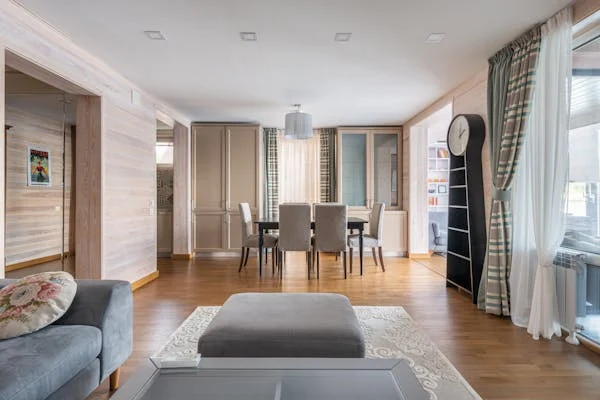We often focus on the air outside, but what about the indoor air, especially in our rental home? It’s easy to overlook, yet indoor air pollution can be 2–5 times worse than outdoor pollution, posing a severe health risk. As renters, we might feel limited in making changes, but even small steps can create a healthier living environment.
This guide provides practical tips to improve your rental home, ensuring you and your loved ones can breathe easier. We’ll understand simple yet effective strategies to combat indoor pollutants, from optimizing ventilation to choosing the right cleaning products.
The Unseen Consequences of Poor Indoor Air Quality
Rental Over 131 million Americans breathe unhealthy air, and 90% spend time indoors. We often underestimate the air we breathe in our homes, assuming it’s better from outside pollution. However, indoor air pollution can be a silent, insidious threat, responsible for 3.2 million deaths annually in 2020. Out of which, over 237,000 were children under 5. This hidden danger hides in the dust, the cleaning products we use, and even the very walls of our homes.
The health consequences of poor indoor air quality are far-reaching. It causes severe risks like respiratory diseases, allergies, and even heart problems. Children, the elderly, and those with existing health conditions are especially vulnerable to these effects. It’s a sobering thought that the air we breathe indoors, where we spend most of our time, can be more harmful than the air outside.
The problem is widespread. A study by Dyson revealed that the UK experienced worse indoor air quality than outdoor air for nearly the entire year. This alarming statistic underscores the urgent need to address indoor air pollution, even in clean outdoor environments. It’s time to recognize this invisible threat and take action to protect ourselves and our loved ones.
Simple Steps for Cleaner Air
Are you tired of feeling stuffy and congested in your own home? Read these secrets to cleaner, healthier air in your rental space. You’ll learn practical tips that are easy to implement, even if you’re not the property owner.
Ventilation
Ventilation is vital to exchange stale, polluted indoor air with fresh, clean air from outside. Just as our lungs expel carbon dioxide and take in oxygen, proper ventilation helps remove harmful pollutants and revitalize air. Ventilation with a 0.3-0.8 time/h rate decreased formaldehyde and volatile organic compounds concentration by 30% to 50%.
Another study revealed that improving ventilation can reduce aerosol transmission diseases by 50% and increase productivity by 1% to 4%. It become even more crucial in a rental home, where you might have limited control over significant systems.
Open windows and doors whenever possible, especially on good outdoor air quality days. This encourages cross-ventilation, allowing fresh air to circulate and push out stagnant air.
Choosing Low-VOC Paints and Cleaning Products
That new paint smell might seem harmless, but it could indicate danger hiding in the air. These odors often indicate the presence of volatile organic compounds or VOCs. These chemicals, released from paints, cleaning products, furniture, and building materials, can significantly impact indoor air quality.
VOCs can irritate your eyes, nose, and throat, causing headaches and dizziness. Long-term exposure can cause more severe health issues, including respiratory problems and even damage to the liver, kidneys, and nervous system.
For example, asbestos, once a popular building material, is now recognized as a hazardous carcinogen. It’s a VOC that can cause devastating diseases like mesothelioma, a rare and aggressive cancer, and asbestosis, a chronic lung disease.
Sadly, many landlords, driven by profit or ignorance, have knowingly concealed the presence of asbestos in their properties in America. This has led to countless individuals unknowingly living with this killer, their health compromised with each breath they take. Many families exposed to asbestos filed lawsuits against the landlord for their negligence. Around 3500 and 4100 lawsuits have been filed yearly in the U.S. civil courts.
You may be wondering, can I sue for asbestos exposure? Yes, if you suspect you or a loved one have been exposed to asbestos in your rental, you’re eligible for asbestos lawsuits. You must hold landlords accountable for providing safe and healthy living environments. Protecting ourselves and our families from preventable illnesses is our right.
TorHoerman Law highlights actionable steps to file a lawsuit:
- Hire an experienced and specialized attorney
- Document your asbestos exposure
- Get medical evidence highlighting the exposure
- Determine parties responsible for exposure
- File your lawsuit
- Negotiate for a reasonable settlement amount
Avoid Burning
While the glow of candles or the crackling of a fireplace might create a cozy ambiance, they also release harmful pollutants. Burning candles, incense, or wood, even in small amounts, can significantly impact indoor air quality. These pollutants can irritate your lungs, trigger respiratory problems, and worsen conditions like asthma.
Fortunately, plenty of healthier alternatives can still create a welcoming atmosphere. Consider switching to essential oil diffusers. You can choose from various essential oils to create a calming, energizing, or uplifting atmosphere.
Reducing Dust and Chemicals
Dust mites, pet dander, and even the chemicals in cleaning products and building materials can contribute to pollutants we breathe in daily. It’s easy to overlook these insignificant sources, but the impact on our health can be substantial. Over time, exposure to these pollutants can trigger allergies, worsen asthma symptoms, and even lead to more serious respiratory problems.
Regular cleaning is crucial, but not just any cleaning will do. A HEPA vacuum cleaner can effectively trap tiny particles like dust mites and pet dander that regular vacuums miss. Wash bedding and other soft furnishings in hot water weekly to kill dust mites and remove allergens.
Monitor Air Quality
An air quality monitor keeps a watchful eye on and measures the levels of various pollutants. This includes those tiny, harmful particles floating in the air from everyday items. It lets you make informed decisions to improve your living environment.
When choosing an air quality monitor, consider its capabilities. Look for one that can detect many pollutants. Real-time data is critical, allowing you to see how your actions, like opening a window or using a particular cleaning product, directly affect the air you breathe. Some monitors even provide alerts when pollution levels rise, allowing you to take immediate action.
Indoor Plants
Indoor plants are like tiny, green air purifiers scattered throughout your home. Research has shown that certain plants can absorb harmful pollutants from the air, acting as natural filters and improving indoor air quality.
Spider plants, snake plants, and peace lilies are just a few known for their air-purifying properties. They absorb pollutants like formaldehyde and benzene, which are often found in household items like furniture and cleaning products.
Beyond cleaner air, indoor plants offer additional benefits that can make a real difference in your rental home. Studies suggest they can reduce stress levels, lower blood pressure, and improve overall well-being.
FAQs
What are the symptoms of poor air quality in a house?
Poor air quality in a house can manifest in various ways, impacting physical and mental well-being. Common symptoms include persistent coughing or sneezing, difficulty breathing, frequent headaches or migraines, and fatigue even with adequate rest. In some cases, poor air quality can also exacerbate existing allergies or respiratory conditions.
What is the most significant cause of poor air quality?
Fossil fuel burning, primarily for energy production and transportation, contributes to poor air quality. Coal, oil, and gasoline combustion release harmful pollutants like particulate matter, nitrogen oxides, and sulfur dioxide into the atmosphere. This leads to various health and environmental problems.
What is the best mask for air pollution?
The best mask for air pollution is an N95 respirator. These masks are specifically designed to filter out airborne particles. This includes the delicate particulate matter that poses the most significant health risk from air pollution.
Taking control of your indoor air quality can be manageable. Even minor adjustments can significantly impact the air you breathe. Implement these tips, prioritize ventilation, and be mindful of hidden dangers. Clean air is not a luxury but a necessity. Breathe deeply, knowing you care for yourself and your loved ones. It’s time to reclaim your home’s air and make every breath count.




















